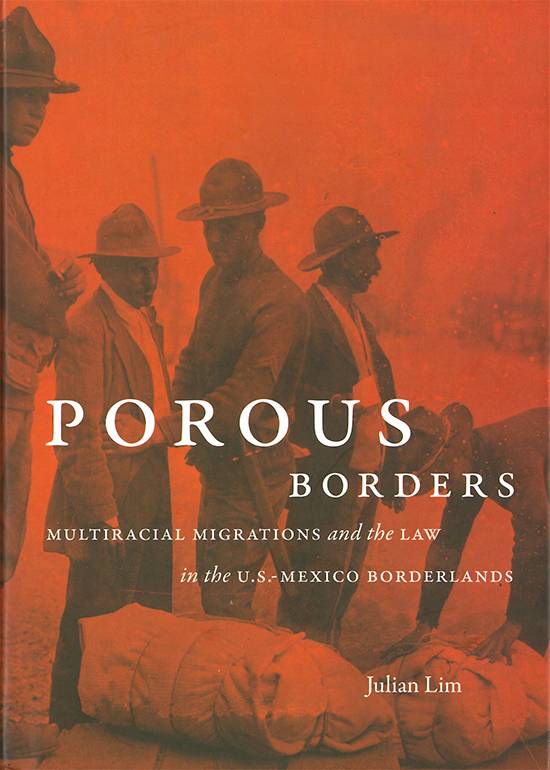
Porous Borders:
Multiracial Migrations and the Law in the U.S. – Mexico Borderlands
by Julian Lim
Chapel Hill: University of North Carolina Press, 2020.
320 pp. $29.95 paperback.
Reviewed by
Ethen Peña
“Because of El Paso’s positionality at the periphery of either nation surrounding it, the city has long been a hub of migration. Lim presents the borderlands, and El Paso in particular, as a place of freedom, particularly for African Americans fleeing the Jim Crow-era South.”
Texas history, typically, is taught largely as a history in which monolithic groups of Anglo settlers from the United States and abroad grappled with Mexicans and, less often mentioned, indigenous groups for control of the “state” before finally enacting the prevailing white supremacist social structure. Almost always absent from that history are the Chinese and black influences on both local border cultures and the broader multi-national discourses on race and citizenship. Of course, as Julian Lim notes in Porous Borders: Multiracial Migrations and the Law in the U.S. – Mexico Borderlands, the erasure of multiethnic, multinational histories from collective memories was purposeful on behalf of the United States and Mexican governments as part of their separate nationalist projects. By casting interactions between black, indigenous, Chinese, and Mexican migrants as rumors, colonial powers kept power firmly entrenched in white/Anglo hegemony. Through illuminating interactions between the above groups, Porous Borders engages with the history of their erasure and the processes colonial powers underwent to remove them from historical/political discussion.
Lim recovers this history from archives ill-equipped to sponsor it by reading against the “traffic habits” of colonialist archives that are themselves tools to “physically reproduce …idealog[ies] of racial differentiation and segregation.” The fruit of that labor demonstrates that the United States and Mexico - while both attempted to create a white national identity in their own image - facilitated the creation of identities in the Borderlands that were more fluid, more interconnected, and more situational than typically credited. Using El Paso – the most permeable cosmopolitan border crossing in the region - as a conduit for examination, Julian Lim broadens the discussion of black and Chinese bodies in Texas’s borderlands to show that they were more than just “there too,” but that the “tensions, contingencies, and complexity at play in borderland communities” were just as existent, if not more robust, for non-Mexicans and non-Anglos.
Because of El Paso’s positionality at the periphery of either nation surrounding it, the city has long been a hub of migration. Lim presents the borderlands, and El Paso in particular, as a place of freedom, particularly for African Americans fleeing the Jim Crow-era South. While Jim Crow style segregations were still technically present in El Paso, they were much more “muted” than in the Deep South, meaning that, relative to counterparts in Alabama or Georgia, black people in El Paso and on the border were able to live, breathe, and even thrive, more freely and with less reservation.
For Chinese immigrants the city offered a number of different opportunities to be gained from exploiting the United States’ racist immigration policies. Trickling into the region as railroads were completed, Chinese migrants to El Paso quickly set up a thriving laundry industry. Their successes, and broader Sinophobic tendencies, informed the creation of the Chinese Exclusion Act of 1882, which exacerbated the policing of groups indigenous to the border region as well. No longer to live and labor in the United States, many Chinese migrants used the government’s racializations to their advantage by simply acting Mexican. Once garbed in a zarape and equipped with the phrase “Yo soy Mexicano,” many Chinese immigrants could slip across unnoticed, exploiting border guard’s phenotypic understandings of race for their own benefit. As Chinese migrants became more successful at flouting United States’ immigration rules, the U.S. became more reactionary and exclusionary of all immigration, “disaggregat[ing] immigrants – one from another - thereby making sense of what they saw as a multiracial mess.”
Lim’s research illustrates an ingenuity and tenacity among migrant groups on the border that often goes unnoticed in borderlands discourse. Far from effectively compartmentalizing indigenous, black, Mexican, and Chinese bodies, Mexican and American solutions of immigration control encouraged migrants from these groups to manipulate American/Mexican racial sensibilities, thus eking out special cultural cross-pollinations that, by their very existence, threatened white/Anglo hegemony.
Lim brings to light many of the obstacles when engaging in the study of the borderlands, namely that archives are not intended to focus on multiethnic histories, thus forcing her breakthrough ideology reinforcing archives.
Ethen Peña is a recent graduate of Texas State with a Masters of History. A scholar-activist, his work seeks to combat the capitalist ideologies, such as those Lim identifies in Porous Borders, that racialize and malign the working-class
